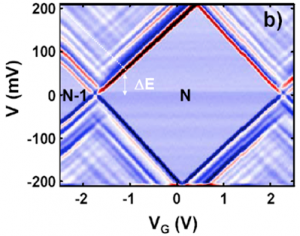Functional Molecules
 Vibrational modes
Vibrational modes
Molecules are floppy systems and electron transport sensitively depends on the presence of vibrational modes in the molecules. Measurements are performed both in the resonant, single-electron-tunneling regime and in the off-resonant regime by means of inelastic tunneling spectroscopy (IETS). Calculations show that in the resonant transport regime, Franck-Condon factors determine the strength of the interactions (especially important for the low-energy excitations (<20 meV)); in the off-resonance regime the dominant modes in the spectrum involve stretching of the pi-bonds involved in transport (mostly high-energy modes > 20 meV).
Porphyronics
Porphyrins are highly-conjugated systems with delocalized π-electrons. Their structural flexibility and well-developed synthetic chemistry allows their physical and chemical properties to be tailored by choosing from a wide library of macrocycle substituents and central metal atoms. Nature itself offers magnificent examples of processes that utilize porphyrins, such as the activation and transport of molecular oxygen in mammals and the harnessing of sunlight in plant photosynthetic systems. To exploit the properties of porphyrins in artificial devices, we need to understand and control the interactions that occur at the molecule-substrate interface, in particular the way in which a single molecule binds to a pair of metallic electrodes. Such interactions largely depend on the electronic and conformational structures of the adsorbed molecules; we study them with mechanically-controllable break junctions.
Quantum interference effects
Using the mechanically controllable break junction technique, we measured the low-bias conductance of molecular junctions where the benzene ring is wired between gold electrodes through thienyl anchoring groups and ethynyl spacers. We find that the conductance for a meta-coupled benzene ring is more than an order of magnitude smaller than that of a para-coupled benzene. The dramatic reduction of the conductance is consistent with destructive quantum interference effects in the meta-coupled benzene. This is supported by non-equilibrium Green’s function calculations that confirm the occurrence of quantum interference in these systems. Currently, more derivatives in which quantum interference effects are expected, are being investigated.
Image and charging effects
We investigate the influence of the metal electrodes on the energy levels in single-molecule junctions using two- and three-terminal mechanically controllable break junctions (MCBJs) in vacuum at 6 K. We find that, by tuning the metal-molecule-metal geometry, significant shifts of occupied and unoccupied molecular orbital levels are induced. The results are corroborated by DFT-based calculations which indicate that to a large extent image charge effects can be held responsible for orbital-level shifts.
Addition energies and vibrational fine structure measured in electromigrated single-molecule junctions based on an oligophenylenevinylene derivative
E.A. Osorio et al. Adv. Mater. 19 (2007) 281
Vibrational Excitations in Weakly Coupled Single-Molecule Junctions: A Computational Analysis
J.S. Seldenthuis, H.S.J. van der Zant, M.A. Ratner and J.M. Thijssen, ACS Nano 2 (2008) 1445
Conductance switching and vibrational fine structure of a [2×2]CoII4 grid-like single molecule contacted in a three-terminal configuration
E.A. Osorio et al., Small 6 (2010) 174
Electroluminescence spectra in weakly coupled single-molecule junctions
J.S. Seldenthuis, H.S.J. van der Zant, M.A. Ratner and J.M. Thijssen, Phys. Rev. B. 81 (2010) 205430
A statistical approach to inelastic electron tunnelling spectroscopy on fullerene terminated molecules
J. Fock et al., Phys. Chem. Chem. Phys. 13 (2011) 14297
Influence of the chemical structure on the stability and conductance of porphyrin single-molecule junction
M.L. Perrin et al., Angewandte Chemie 50 (2011) 11223
Charge transport in a zinc–porphyrin single-molecule junction
M.L. Perrin et al., Beilstein J. Nanotechnol. 2 (2011) 714
Signatures of quantum interference effects on charge transport through a single benzene ring
C.R. Arroyo et al., Angewandte Chemie 52 (2013) 3152
Large tunable image-charge effects in single-molecule junctions
M.L. Perrin et al., Nature Nanotechnol. 8 (2013) 282
Statistical analysis of single-molecule breaking traces
R Frisenda et al., Phys. Status Solidi B (2013)
